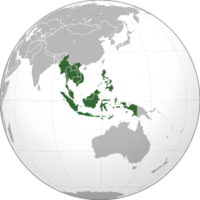Christianity in Asia
 From Conservapedia - Reading time: 5 min
From Conservapedia - Reading time: 5 min
Christianity in Asia goes right back to the Apostolic and divine foundations of Christianity by Jesus Christ Our Lord and His holy Apostles. Israel being situated in Asia, it was Asia itself that was the first to hear the Word of God. St. Thomas the Apostle preached and was martyred in India, showing Christianity had already reached the Far East before the end of the First Century A.D. The First Ecumenical Council was the Council of Nicaea in Asia Minor in 325 A.D. There is a plan to commemorate the Synod in Nicaea in 2025.[1]
Contents
Growth of Christianity in China[edit]
See also: Growth of Christianity in China
In 2020, The Economist published an article entitled Protestant Christianity is booming in China which indicated:
| “ | As for China’s Christians, their numbers continue to grow. The government reckons that about 200m of China’s 1.4bn people are religious. Although most practice traditional Chinese religions such as Taoism, and longer-standing foreign imports such as Buddhism, Protestant Christianity is probably the fastest-growing faith, with at least 38m adherents today (about 3% of the population), up from 22m a decade ago, according to the government’s count. The true number is probably much higher: perhaps as many as 22m more Chinese Protestants worship in unregistered “underground” churches, according to a new study by researchers at the University of Notre Dame. As China also has 10m-12m Catholics, there are more Christians in China today than in France (38m) or Germany (43m). Combined, Christians and the country’s estimated 23m Muslims may now outnumber the membership of the Communist Party (92m). Indeed, an unknown number of party members go to church as well as local committee meetings.[2] | ” |
To see the magnitude of the explosive growth of Christianity in China, examine this graph about the growth of Christianity in China in a DW news story about Chinese Christianity (DW is a mainstream news outlet in Germany). There are now more Christians in China than Chinese who belong to the Communist Party of China (see also: East Asia and global desecularization).[3]
For more information, please see:
Ethnic Chinese and a rapid rise of charismatic Christainity in Asian countries[edit]
See also: Ethnic Chinese and the rise of Christianity in Southeast Asia

Singapore Management University reports:
| “ | ...more and more people in Southeast Asia are converting to Christianity. But these new converts – mostly ethnic Chinese – are drawn particularly to charismatic Christianity.
This new wave of religious fervour accounts for the rise of “mega churches” in this part of the world. Juliette Koning and her colleague, Heidi Dahles of VU University Amsterdam, had been studying Indonesia and Malaysia respectively when they first took notice of how many ethnic Chinese business managers were embracing charismatic Christianity. They decided to study this phenomenon through an anthropological lens and presented their findings in their paper, 'Spiritual Power: Ethnic Chinese Managers and the Rise of Charismatic Christianity in Southeast Asia'... Koning noted that there was a rapid expansion of charismatic Christianity from the 1980s onwards. Singapore, China, Hong Kong, Taiwan, Indonesia and Malaysia are said to have the fastest-growing Christian communities and the majority of the new believers are “upwardly mobile, urban, middle-class Chinese”. Asia has the second largest Pentecostal-charismatic Christians of any continent, with the number growing from 10 million to 135 million between 1970 and 2000.[6] |
” |
Eurasia Review reports:
| “ | The independent Pentecostal movement has been growing rapidly in Southeast Asia in recent decades, benefitting from the broader expansion of charismatic Christianity from the 1980s onwards in Singapore, Indonesia and Malaysia, as well as further afield in Taiwan and South Korea.
There are several reasons why the growth of this movement in this region is important. Firstly, to a large extent the Pentecostal movement has an ethnic face. The majority of Pentecostals in urban centres like Kuala Lumpur, Singapore, Surabaya, Jakarta and Manila are, with some notable exceptions, upwardly mobile, middle-class ethnic Chinese. In countries where the ethnic Chinese are in the minority, Pentecostal churches and cell groups are crucial spaces for social networking, business contacts and identity-making. Secondly, it has a wide economic appeal suggesting an ability to tap into different concerns and aspirations. For while the megachurch, the most popular incarnation of independent Pentecostalism, is often associated with the middle classes, it has great attraction for the poor and the working class in urban centres like Manila. Thirdly, the central figure of the charismatic leader in Pentecostal churches means that senior pastors enjoy great deference and sway over large congregations.[7] |
” |
South Korea[edit]

In 2005, according to figures compiled by the South Korean National Statistical Office, 46.5% of the population were classified as irreligious, compared to 22.8% Buddhists, 18.3% Protestants, 10.9% Catholics, and 1.7% Other religions.[9]
John Mark Terry writes in his paper The Growth of Christianity in East Asia:
| “ | South Korea represents one of international missions’s great successes. Flying into Seoul at night is a blessing for a Christian. One can see florescent crosses on top of church buildings all over the city. During the 1970s and 80s Christianity grew tremendously in Korea. That explosive growth has slowed now, but Christians comprise 31 percent of the population. The Korean churches have embraced the cause of international missions, and they have sent more than 20,000 missionaries throughout the world. At first these missionaries primarily ministered to Koreans living abroad, but improved missionary training has brought a greater emphasis on crosscultural mission.[10] | ” |
Like most atheists, the atheists of South Korea are not sending out atheist activists to other countries to spread atheism around the world (See: Atheism and apathy).
Philippines[edit]
Catholics are the majority religion in the Philippines. Protestants are the second largest religious group in the Philippines.
According to Wikipedia, an online encyclopedia founded by an atheist and agnostic, "Irreligion in the Philippines is particularly rare among Filipinos...".[11]
Mongolia and global[edit]
In the early 1980s there were only a handful of known Christian believers in Mongolia. In 2011, Mongolia per capita sent out more Christian missionaries than any country in the world.[12]
India[edit]
The Indian Orthodox Church is one of the oldest denominations of Christianity, originating in India around 52 AD, when St. Thomas the Apostle traveled to India. The church is also called Malankara Orthodox Church, Orthodox Church of the East, Malankara Orthodox Syrian Church, Orthodox Syrian Church of the East [13]
See also[edit]
- Global Christianity
- Christianity by continent
- Future of Christianity
- Christianity in Africa
- Christianity in Australia
- Christianity in Europe
- Christianity in North America
- Christianity in South America
- (Indian) Malankara Orthodox Church
References[edit]
- ↑ http://www.asianews.it/news-en/Bartholomew:-With-Francis,-we-invite-all-Christians-to-celebrate-the-first-synod-of-Nicaea-in-2025-31213.html
- ↑ Protestant Christianity is booming in China, The Economist, Sep 15th 2020
- ↑ In Xi we trust - Is China cracking down on Christianity?, DW News
- ↑ The State Of Pentecostalism In Southeast Asia: Ethnicity, Class And Leadership – Analysis, Eurasia Review
- ↑ UNDERSTANDING THE RAPID RISE OF CHARISMATIC CHRISTIANITY IN SOUTHEAST ASIA, Singapore Management University, 2010
- ↑ UNDERSTANDING THE RAPID RISE OF CHARISMATIC CHRISTIANITY IN SOUTHEAST ASIA, Singapore Management University, 2010
- ↑ The State Of Pentecostalism In Southeast Asia: Ethnicity, Class And Leadership – Analysis, Eurasia Review
- ↑ The Growth of Christianity in East Asia
- ↑ According to figures compiled by the South Korean [[National Statistical Office (South Korea)|]]. 인구,가구/시도별 종교인구/시도별 종교인구 (2005년 인구총조사). NSO online KOSIS database. Retrieved on August 23, 2006.
- ↑ The Growth of Christianity in East Asia
- ↑ Irreligion in the Philippines, July 2018, "Irreligion in the Philippines is particularly rare among Filipinos...".
- ↑ Phill Butler : The Mongolia Story
- ↑ St Thomas Detroit, " History of Indian Orthodox Church ". [1]
 KSF
KSF